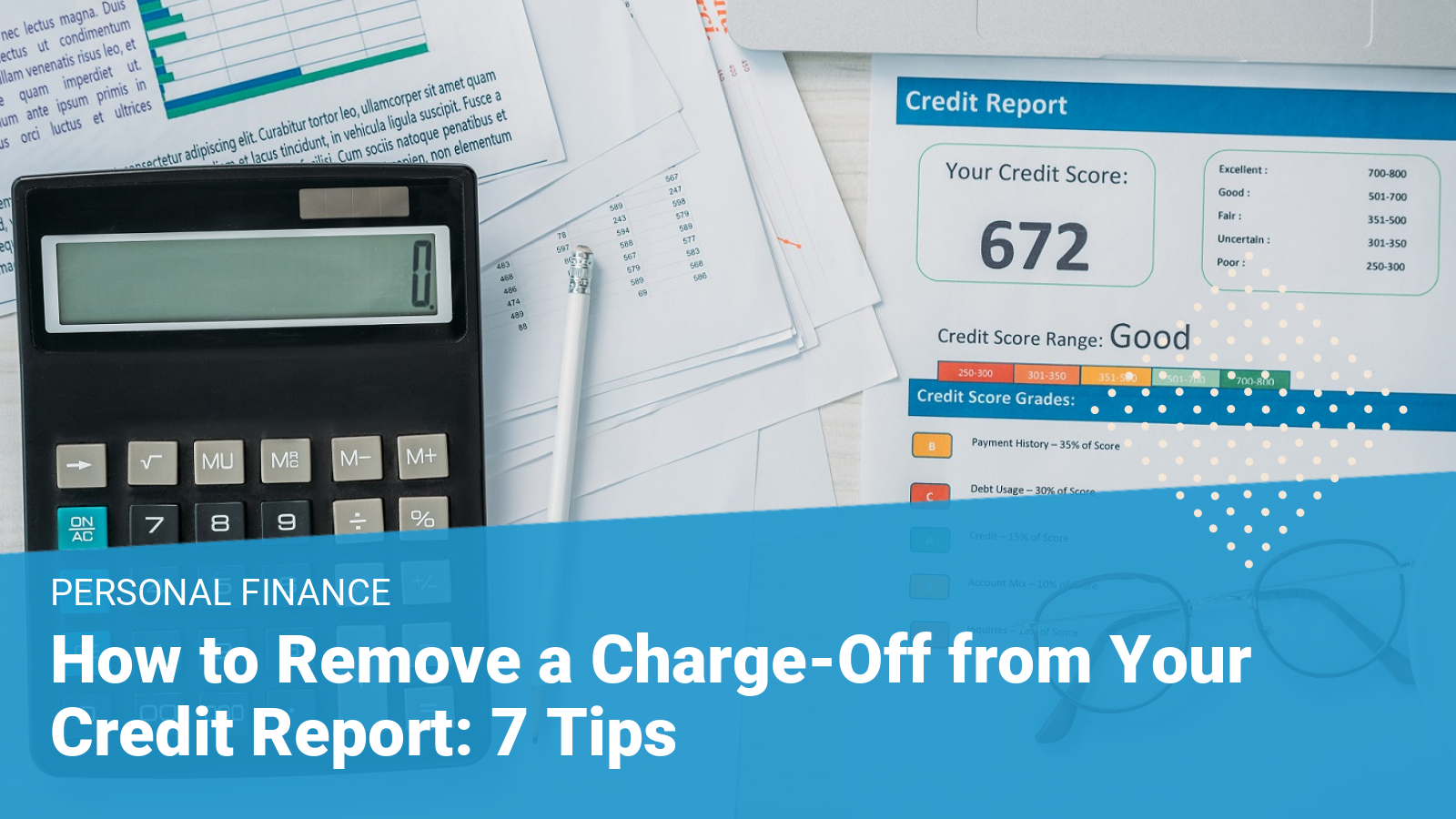Charge-off accounts can actually affect your creditworthiness so it’s important to know how to remove a charge-off from your credit report.
You may not be approved for the loan that you want, or you might not receive the best terms. Higher interest rates can lead to subprime loan terms that could cost you thousands of dollars over the loan’s life.
If you repay a charge-off within the seven-year period it will stay on your credit report but may have a lesser negative impact on your score.
You can avoid the credit damage that a charge-off account can do to your credit by taking steps to get rid of it. While you can’t guarantee that you will get the results you want, it’s worth trying to remove them.
Here are seven easy tips on how to remove a charge off from your credit report.
1. For charge-off accounts, review your credit report
Understanding the entire charge-off account is what you should do first. You’ll first need to check your credit report. Each credit reporting agency (CRA) – TransUnion, Equifax, and Experian – gives you a free credit report every year.
You can also request your free credit report:
- Online: AnnualCreditReport.com
- Phone: (877) 322-8228
You can also download the request form and mail to:
Annual Credit Report Request Service
P.O. Box 105281
Atlanta, GA 30348-5281
When viewing your credit report you may find the information you’re looking for in the “credit history” and “accounts” sections.
These sections contain information about missed or late payments, as well as details on collection accounts and other debts.
Next, look at the section titled “negative information” (sometimes called “public records”). You’ll find all negative items that could lower your credit score.
These include bankruptcies and foreclosures as well as charge-offs, late payments, repossessions, or delinquent payments.
Before you respond to a collection request, make sure you check your state’s statute of limitations.
You should verify the accuracy of this information. You can correct or delete any information that you believe has been incorrectly reported to credit reporting agencies (which we’ll talk about below).
2. Add the details of your debt
Once you have found your credit report and done some research, it is time to collect and verify all details about the overdue debt. This is an important step because you can dispute any errors and get some relief.
These are the details that you should be aware of:
- Account Number: The number is associated with your creditor.
- Name of the original creditor: The company that billed you for the service or product.
- Opening date: When you opened your account.
- Charge-off Date: When your original creditor declares your debt non-collectible and removes it from their books
- History of payments: This record shows when you have made and missed payments, as well as the last date your account was active.
- Names of the borrower: Who is connected to the loan.
- Balance What you ow.
You should pay particular attention to details such as the date, amount outstanding, and type of debt. Collection agencies might report that the date they bought your account may be the date it was inactive.
This is different from the date it was charged off by your creditor.
This can prolong the period of time that this debt has an effect on your credit score. Older charge-offs will have less impact on your credit score.
Also, you should check your account balance to see if there are any additional fees that have been added to the debt.
While you might have to pay additional late fees or penalties, the fee schedule should match that of your original creditor. The balance of your account is not subject to bogus fees.
Make sure that you know the name and attachment of the debt. Creditors often mix people with similar names and their debt with others.
3. Inform the credit bureaus of incorrect charge-offs
If you discover incorrect information about the account, contest it. You can file a dispute with any credit bureau about the incorrect account information.
It is important that you have all supporting documentation to support your claim about the incorrect charge-off. These documents could include invoices, contract signatures, and account statements.
The credit bureau may accept any type of documentation that can prove your case or verify the details of the debt.
After you have submitted the information to the relevant credit bureau, they will investigate your claim. They must remove or correct any charge-offs if there is an error according to the Fair Credit Reporting Act.
If you want, you may also file a dispute with the original creditor.
Both parties must conclude their investigation and make a decision on the dispute within 30 working days.
4. Try to pay off the debt if it is true and unpaid
Bad credit scores can be caused by a valid charge-off account that is still visible on your credit report. Paying off the charge will not have a significant negative effect.
Credit scoring models such as VantageScore won’t lower consumers’ scores for older accounts with paid-off charges.
You have the option to pay the entire balance in one lump sum or in equal installments. You can settle the account for a lesser amount.
While paying the full amount looks more impressive on your credit report rather than settling the account, it is better to do something about a charge-off on your profile than having an unpaid one.
5. Consider a pay-for-delete agreement if you are unable to pay the entire amount
You can negotiate a payment-for-delete agreement for a charge-off.
Pay-for-delete allows you to pay a portion or all of the outstanding debt and the information is removed from your file.
This is not a requirement that creditors have to do, but it may work in certain cases. You should get the agreement written if you are able to negotiate an arrangement. This is particularly important if the other party refuses to contact CRAs to close the account.
You can send a letter to the credit bureaus with the details.
6. All details should be written
You should get all terms in writing if you negotiate a payment arrangement. The agreement you get should be written on company letterhead and should also accurately capture the agreement.
Verify that all details are correct once you have received them in writing.
You may also request an update from the person who is responsible for executing the agreement.
You should contact the creditor, debt collection agency, or CRA if you have not received a letter in writing. Keep at it until you receive the written agreement based on the details of the deal that you have negotiated.
7. If you require credit repair assistance, hire a company
Credit repair agencies like CreditRepair.com and Credit Saint can help you remove charge-offs from your report. Even though they can do the exact same job as you, they can get the job done faster and get better results.
They may also be able to offer advice on personal finance matters that could help you improve your credit score.
💡 Read more: 8 Ways to Improve Your Credit Score
Proper vetting is important when working with credit repair companies. You should ensure that the credit repair company you choose is reliable and uses non-fraudulent methods to remove any charge-offs from your credit report.
To ensure that the company isn’t engaging in unethical or shady practices regarding credit repair, look at sites such as Trustpilot, Google reviews, the Better Business Bureau, and the Consumer Financial Protection Bureau (CFPB).
FAQs
What is a charge-off?
Charged-off accounts are those that your creditor marked as uncollectible. They are taken off their books. Let’s say you have fallen behind on credit card payments or have accumulated significant card debt. If you are found to be in default on your payments (no payment has been made within 180 days), the card issuer can write off the debt as bad.
The creditor will report the charge-off to the credit reporting agencies. This updates your credit file. The creditor may typically sell the account to a third-party (a debt collector) who will get in touch with you to follow-up on the charge-off debt.
What do charge-offs mean for your credit score?
A charge-off account can have a negative effect on your credit score. You can reduce the negative impact of a charge-off by taking the time to pay the balance or passing the time.
What length of time does a charge-off remain on your credit report
Up to seven years. The seven-year clock starts with the date the account was first reported as late. This is usually done by the creditor.
Is it possible to remove a charge-off and not have to pay?
It is very unlikely that your account will be removed if it is accurate and valid. This information should be deleted from the report, regardless of whether or not you pay it.
What should you do if the charge-off is not removed?
You can try to reduce the impact it has on credit scores if you are unable to remove the charge-off. You can pay off the entire debt, or let it go. You should also work to improve your credit score with some of your other accounts, such as building new credit. Your score should eventually recover.
Sources
- VantageScoreaccessed on October 31, 2022
- Credit.orgaccessed on October 31, 2022
- Federal Trade Commissionaccessed on October 31, 2022


